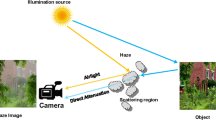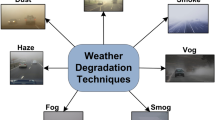Abstract
Refining visibility through haze removal from image becomes an inevitable chore and essential to recognize and track vehicles, traffic signal, and signs clearly under road safety. That can face a recurrent degradation under destitute climatic circumstances for instance fog, rain, cloud, and smog. To diminish this constraint, various methods were designed and implemented, but most were not capable of obtaining the improved quantitative outcomes. Therefore, a new algorithm Fog Elimination using Multiple Thresholds (FEMT) for single image haze eviction that meritoriously obtains the significant results on both gray and colored over real and synthetic images using multiple thresholds is proposed in this paper. The proposed method targets on the light regions by reducing the brightness and increasing the contrast of image at different levels. Finally, by grouping all the obtained resultant images leads to the generation of the resultant defogged image. The qualitative and quantitative analysis is carried out for an assessment of digitalized de-hazed images acquired from the proposed algorithm and compared to the prior techniques. Simulated fallouts entitle high resemblance to the corresponding ground truth, reduction in computation time consumption to 88% and error of 98%. The proposed approach can be applied in the field of robotics, human activity monitoring, smart systems, and digital investigation on the hazy images.





Similar content being viewed by others
References
Ali M, Son LH, Khan M, Tung NT (2018) Segmentation of dental X-ray images in medical imaging using neutrosophic orthogonal matrices. Expert Syst Appl 91:434–441
Ancuti CO and Timisoara UP (2016) D-HAZY : A dataset to evaluate quantitatively dehazing algorithms. in IEEE Conference on Image Processing, pp. 1–5.
Ancuti CO, Ancuti C, Hermans C, and Bekaert P (2011) A fast semi-inverse approach to detect and remove the haze from a single image. Comput Vis, pp. 501–514.
Anwar I, Khosla A (2017) Vision enhancement through single image fog removal. Elsevier, Eng. Sci. Technol. an Int. J., vol. In Press
Economopoulos TL, Asvestas PA, Matsopoulos GK (2010) Contrast enhancement of images using partitioned iterated function systems. Image Vis Comput Elsevier 28:45–54
Eksioglu EM (2014) Online dictionary learning algorithm with periodic updates and its application to image denoising. Expert Syst Appl 41(8):3682–3690
Fattal R (2008) Single image dehazing. ACM Trans. Graph., vol. 27, no. 3.
Ganeshan VRP (2014) Assessment of satellite image segmentation in RGB and HSV color space using image quality measures. Int Conf Adv Electr Eng
Hassan MK, El Desouky AI, Badawy MM, Sarhan AM, Elhoseny M, and Gunasekaran M (May, 2018) EoT-driven hybrid ambient assisted living framework with naïve Bayes – firefly algorithm EoT-driven hybrid ambient assisted living framework with naı ¨ ve Bayes – firefly algorithm,” Neural Comput. Appl., no.
He K, Sun J, Tang X (2011) Single image haze removal using Dark Channel prior. IEEE Trans Pattern Anal Mach Intell 33(12):2341–2353
Huang S, Chen B, Cheng Y (2014) An efficient visibility enhancement algorithm for road scenes captured by intelligent transportation systems. IEEE Trans Intell Transp Syst 15(5):2321–2332
Issac A, Kishore M, and Carlos D (2018) Automatic computer vision-based detection and quantitative analysis of indicative parameters for grading of diabetic retinopathy. Neural Comput. Appl., vol. 0123456789.
Kala R, Deepa P (2017) Adaptive hexagonal fuzzy hybrid filter for Rician noise removal in MRI images. Neural Comput
Kim JH, Akram F, Choi KN (2017) Image denoising feedback framework using split Bregman approach. Expert Syst Appl 87:252–266
Kratz L, Ko N (2009) Factorizing scene Albedo and Depth from a single foggy image. in IEEE Conference on Computer Vision (ICCv), pp. 1701–1708.
Li C, Lu X, Tong C, Zeng W (2014) A fog level detection method based on grayscale features,” in IEEE International Symposium on Computational Intelligence and Design A Fog Level Detection Method Based On Grayscale Features, pp. 418–421.
Li L, Ge H, Zhang Y, and Gao J (2016) Low-density noise removal based on lambda multi-diagonal matrix filter for binary image. Neural Comput Appl
Liu C, Lu X, Ji S, and Geng W (2014) A fog level detection method based on image HSV color histogram, in IEEE, In Progress in Informatics and Computing, pp. 373–377.
Mahajan T, Gill JS (2017) A review on haze removal algorithms to reduce the effect of haze on remotely sensed images. Adv Comput Sci Technol 10(5):1327–1335
Meng G, Wang Y, Duan J, Xiang S, and Pan C (2013) Efficient image dehazing with boundary constraint and contextual regularization. in IEEE international Conference on Computer Vision, pp. 617–624.
Serikawa S, Lu H (2014) Underwater image dehazing using joint trilateral filter. Elsevier Comput Electr Eng 40:41–50
Sharma G, Wu W, Dalal EN (2005) The CIEDE2000 color-difference formula: implementation notes. Supplementary Test Data, and Mathematical Observations 30(1):21–30
Sun C, Lai H (2016) Single image fog removal algorithm based on an improved dark channel prior method, in IEEE, In Intelligent Signal Processing and Communkication Systems, pp. 1–4.
Tan RT (2008) Visibility in bad weather from a single image, in Computer Vision and Pattern Recognition, pp. 1–8.
Tarel J, Hauti N (2009) Fast visibility restoration from a single color or gray level image. in IEEE Conference on Computer Vision (ICCv), pp. 2201–2208.
Tarel J, Hauti N (2010) Improved visibility of road scene images under heterogeneous fog,” in IEEE Intelligent Vehicles Symposium, pp. 478–485.
Tarel J, Hautière N, Caraffa L, Cord A, Halmaoui H, and Gruyer D (2012) Vision enhancement in homogeneous and heterogenous fog. IEEE Intell Transp Syst Mag., no. April, pp. 6–20
Zhang S, He F (2019) DRCDN : learning deep residual convolutional dehazing networks. Vis Comput, no. 1
Zhang J, He F, Chen Y (2019) A new haze removal approach for sky / river alike scenes based on external and internal clues. Multimed Tools Appl 79:2085–2107
Zhang S, He F, Ren W, Yao J (2020) Joint learning of image detail and transmission map for single image dehazing. Vis Comput 36(1):305–316
Zhu Q, Mai J, Shao L, Member S (2015) A fast single image haze removal algorithm using color attenuation prior. IEEE Trans Pattern Anal Mach Intell 24(11):3522–3533
Author information
Authors and Affiliations
Corresponding author
Ethics declarations
Conflict of interest
We have no conflicts of interest in this work.
Additional information
Publisher’s note
Springer Nature remains neutral with regard to jurisdictional claims in published maps and institutional affiliations.
Rights and permissions
About this article
Cite this article
Mittal, M., Kumar, M., Verma, A. et al. FEMT: a computational approach for fog elimination using multiple thresholds. Multimed Tools Appl 80, 227–241 (2021). https://doi.org/10.1007/s11042-020-09657-0
Received:
Revised:
Accepted:
Published:
Issue Date:
DOI: https://doi.org/10.1007/s11042-020-09657-0




